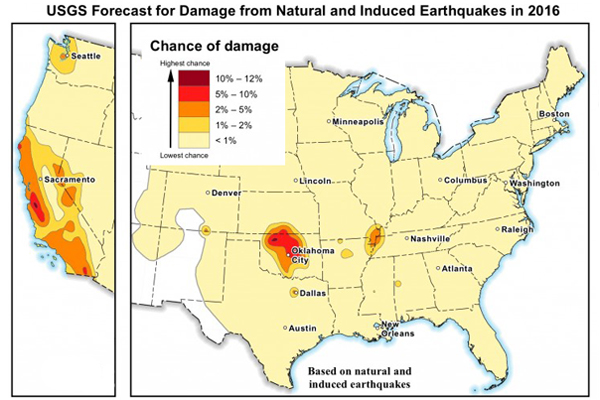By Curtis D. Tucker, Enid Buzz | Monday, March 28, 2016
-
Induced Earthquakes Raise Chances of Damaging Shaking in 2016
-
ENID, Okla. - The United States Geological Survey has released new maps identifying potential earthquake area from both human-induced and natural causes for the first time. Before, USGS maps only identified natural earthquake areas. This is also the first one-year outlook for the nation’s earthquake hazards, which now supplements the 50-year outlook.
-
The one-year report shows that as many as 7 million people live in areas of the central and eastern U.S. (CEUS) with potential for damaging shaking from induced earthquakes including a large portion of Oklahoma. Within a large area of Oklahoma, the chance of damage from all types of earthquakes is similar to that of natural earthquakes in high-hazard areas of California (left box on map).
-
Induced earthquakes are thought to be triggered by human activities, with wastewater disposal being the primary cause for recent events in many areas of the CEUS. The highest chance of hazards from induced earthquakes are in six states, listed in order from highest to lowest potential hazard: Oklahoma, Kansas, Texas, Colorado, New Mexico and Arkansas. Oklahoma and Texas have the largest populations exposed to induced earthquakes.
-
The USGS recommends that people living in areas of high earthquake hazards should learn how to be prepared. Guidelines can be found through FEMA’s Ready Campaign. Enid and Northwest Oklahoma are in the areas with the highest chance of earthquake damage.
-
According to USGS, the central U.S. has undergone the most dramatic increase in seismicity over the past six years. From 1973 to 2008, there was an average of 24 earthquakes of magnitude 3.0 and larger per year. From 2009 to 2015, the rate steadily increased, averaging 318 per year and peaking in 2015 with 1,010 earthquakes. Through mid-March in 2016, there have been 226 earthquakes of magnitude 3.0 and larger in the central U.S. region. To date, the largest earthquake located near several active injection wells was a magnitude 5.6 in 2011 near Prague, Oklahoma.
-
Determining whether earthquakes are natural or human-induced, the USGS relies on published literature and discussions with different state officials along with the scientific and earthquake engineering community. Scientists look at factors such as whether an earthquake occurs near a wastewater disposal well and whether the well is active at the time these earthquakes occur. If so, it is classified as an induced quake.
-
More details from this report can be found here.
-

-








Earthquake shook couch and ceiling fan at 1155 pm tonight
Perfect timing right after this report.